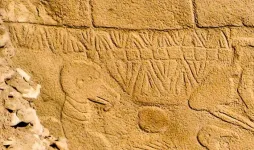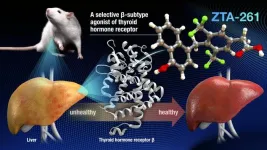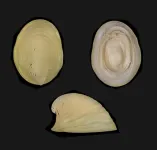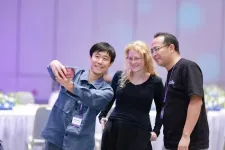(Press-News.org) Markings on a stone pillar at a 12,000 year-old archaeological site in Turkey likely represent the world’s oldest solar calendar, created as a memorial to a devastating comet strike, experts suggest.
The markings at Göbekli Tepe in southern Turkey – an ancient complex of temple-like enclosures adorned with intricately carved symbols – could record an astronomical event that triggered a key shift in human civilisation, researchers say.
The research suggests ancient people were able to record their observations of the sun, moon and constellations in the form of a solar calendar, created to keep track of time and mark the change of seasons.
Fresh analysis of V-shaped symbols carved onto pillars at the site has found that each V could represent a single day. This interpretation allowed researchers to count a solar calendar of 365 days on one of the pillars, consisting of 12 lunar months plus 11 extra days.
The summer solstice appears as a separate, special day, represented by a V worn around the neck of a bird-like beast thought to represent the summer solstice constellation at the time. Other statues nearby, possibly representing deities, have been found with similar V-markings at their necks.
Since both the moon’s and the sun’s cycles are depicted, the carvings could represent the world’s earliest so-called lunisolar calendar, based on the phases of the moon and the position of the sun – pre-dating other known calendars of this type by many millennia.
Ancient people may have created these carvings at Göbekli Tepe to record the date a swarm of comet fragments hit Earth nearly 13,000 years ago – or 10,850 BC – researchers say.
The comet strike is suggested to have ushered in a mini ice age lasting over 1,200 years, wiping out many species of large animals. It could also have triggered changes in lifestyle and agriculture thought to be linked to the birth of civilisation soon afterwards in the fertile crescent of West Asia.
Another pillar at the site appears to picture the Taurid meteor stream – which is thought to be the source of the comet fragments – lasting 27 days and emanating from the directions of Aquarius and Pisces.
The find also appears to confirm that ancient people were able to record dates using precession – the wobble in Earth’s axis which affects the movement of constellations across the sky – at least 10,000 years before the phenomenon was documented by Hipparchus of Ancient Greece in 150 BC.
The carvings appear to have remained important to the people of Göbekli Tepe for millennia, suggesting the impact event may have triggered a new cult or religion that influenced the development of civilisation.
The find also supports a theory that Earth faces increased comet strikes as its orbit crosses the path of circling comet fragments, which we normally experience as meteor streams.
Dr Martin Sweatman, of the University of Edinburgh’s School of Engineering, who led the research, said:
“It appears the inhabitants of Göbekli Tepe were keen observers of the sky, which is to be expected given their world had been devastated by a comet strike. This event might have triggered civilisation by initiating a new religion and by motivating developments in agriculture to cope with the cold climate. Possibly, their attempts to record what they saw are the first steps towards the development of writing millennia later.”
The research is published in Time and Mind.
For further information, please contact: Naomi Imms, Press and PR Office, 07814 226015, naomi.imms@ed.ac.uk
END
Carvings at ancient monument may be world’s oldest calendar
2024-08-06
ELSE PRESS RELEASES FROM THIS DATE:
Sport or snack? How our brain decides
2024-08-06
In brief:
The chemical messenger orexin and the orexin neurons in the brain mediate the decision between exercise and snacking. Researchers at ETH Zurich made this discovery in mice. The results are likely to be transferable to humans.
In the experiment, mice with a blocked orexin system opted more frequently for the milkshake offered them and less for exercise.
These results could help in researching and developing new strategies to promote physical activity in people.
Should I go and exercise, or would I rather go to the café ...
A new way of thinking about the economy could help protect the Amazon, and help its people thrive
2024-08-06
To protect the Amazon and support the wellbeing of its people, its economy needs to shift from environmentally harmful production to a model built around the diversity of indigenous and rural communities, and standing forests.
A group of conservationists from Bolivia, Brazil, Peru, Ecuador, the US and the UK say that current conservation and development efforts will never sustain or scale without systemic changes in how economies are designed.
Despite extensive destruction of the Amazon in the name of economic development, Amazonian communities have seen little improvement in income, life expectancy, and education. The researchers have ...
Controlling lipid levels with less side effects possible with new drug
2024-08-06
Scientists at Nagoya University in Japan have made a significant breakthrough in treating lipid disorders. They have developed a new compound, ZTA-261, which selectively binds to the thyroid hormone receptor beta (THRβ). THRβ plays an important role in the regulation of lipid metabolism, which affects lipid levels in the blood. Mice administered the drug showed decreased lipid levels in the liver and blood, with fewer side effects in the liver, heart, and bones compared to existing compounds. These findings, published in Communications Medicine, suggest that ZTA-261 ...
Research spotlight: Analyzing the effectiveness of heart therapies and outcomes for patients with chip
2024-08-06
Nicholas A. Marston, MD, MPH, of the TIMI Study Group and Carl J. and Ruth Shapiro Cardiovascular Center at Brigham and Women’s Hospital, is the corresponding author of a paper published in Nature Medicine, “Clonal hematopoiesis, cardiovascular events and treatment benefit in 63,700 individuals from five TIMI randomized trials.”
How would you summarize your study for a lay audience?
Clonal hematopoiesis of indeterminate potential (CHIP) is a condition that promotes the multiplication of blood stem cells in the body and increases the ...
Soft gold enables connections between nerves and electronics
2024-08-06
Gold does not readily lend itself to being turned into long, thin threads. But researchers at Linköping University in Sweden have now managed to create gold nanowires and develop soft electrodes that can be connected to the nervous system. The electrodes are soft as nerves, stretchable and electrically conductive, and are projected to last for a long time in the body.
Some people have a “heart of gold”, so why not “nerves of gold”? In the future, it may be possible to use this precious metal in soft interfaces to connect electronics to the nervous system for medical ...
The race to discover biodiversity: 11 new marine species and a new platform for rapid species description
2024-08-06
Accelerating global change continues to threaten Earth’s vast biodiversity, including in the oceans, which remain largely unexplored. To date, only a small fraction of an estimated two million total living marine species have been named and described. A major challenge is the time it takes to scientifically describe and publish a new species, which is a crucial step in studying and protecting these species. The current scientific and publishing landscape often results in decade-long delays (20-40 years) from the discovery of a new species to its official description. As an ...
18th Annual Q-Bio Conference: Global scholars explore new Frontiers in quantitative biology
2024-08-06
The 18th Q-Bio Conference on Quantitative Biology was held at the Guangming Yungu International Conference Center in Shenzhen from July 26 to 29, 2024. Organized by the Shenzhen Institute of Advanced Technology (SIAT) of the Chinese Academy of Sciences (CAS), the Shenzhen Institute of Synthetic Biology (iSynBio), and Peking University, the conference drew over 230 global researchers from countries including the U.S., U.K., France, India, Japan, Chile, and China.
Themed "Predictive Modeling and Quantitative Principles in Complex Biological Systems," the event explored future prospects in quantitative and synthetic biology. Under ...
Eating more fruits & vegetables to reduce dietary acid lowers blood pressure and improves kidney and heart health in patients with hypertension
2024-08-06
Philadelphia, August 6, 2024 – Doctors recommend making fruits and vegetables a foundational part of the treatment of patients with hypertension. Diets high in fruits and vegetables are found to lower blood pressure, reduce cardiovascular risk, and improve kidney health due to their base-producing effects. A new study in The American Journal of Medicine, published by Elsevier, details the findings from a five-year interventional randomized control trial.
Despite ongoing efforts to improve hypertension treatment and reduce its adverse outcomes with pharmacological strategies, hypertension-related chronic kidney disease and its cardiovascular mortality are increasing. Heart disease ...
Rising toll of serious injuries linked to expanded Mexico-US border wall crossing
2024-08-06
The expansion of the Mexico-US border wall crossing has been accompanied by a rising toll of serious injuries, with poor discharge care and a lack of appropriate interpreting facilities adding up to a “humanitarian and health crisis,” suggest researchers in the open access journal Trauma Surgery & Acute Care Open.
Thirty eight different nationalities and 21 languages other than Spanish were represented among those attempting to cross one segment of the wall in 2021 and 2022, say the researchers.
The Mexico-US border wall was extended by 50 miles and raised to a height of 30 feet in Southern California, construction ...
Interplay of sex, marital status, education, race linked to 18 year US lifespan gap
2024-08-06
The interplay of a quartet of sex, marital status, education, and race is linked to an 18 year lifespan gap for US citizens, and while no one factor is more influential than any of the others, the more of these influential factors a person has, the higher their risk of an earlier death, finds research published in the open access journal BMJ Open.
But a simple scoring system based on these characteristics can help overcome this complexity to identify those most at risk, say the researchers.
Individual risks and genetic factors explain part of the differences in health and death, but the evidence increasingly points to the role of social determinants—the ...




